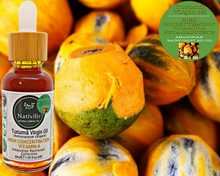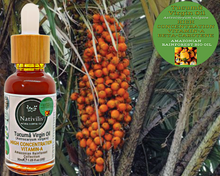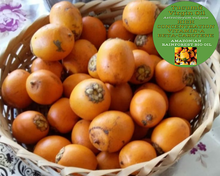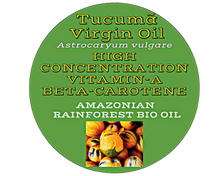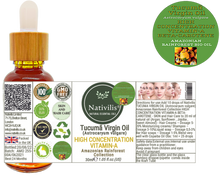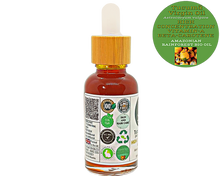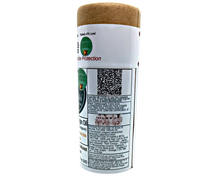

Nativilis TUCUMA VIRGIN OIL (Astrocaryum vulgare) Amazonian Rainforest Collection HIGH CONCENTRATION VITAMIN-A BETA-CAROTENE - SKIN and Hair Care - nourishing, moisturizing, antioxidant and anti-inflammatory properties - Copaiba
HARVEST PERIOD

PHYSICAL-CHEMICAL DATA AND APPLICATIONS

The Nativilis TUCUMA VIRGIN OIL Amazonian Rainforest Collection (Astrocaryum vulgare) extracted from the pulp contains 25.6% saturated fatty acids and 74.4% unsaturated fatty acids composed of palmitic, stearic, oleic, and linoleic acids. As it is rich in omega 3, 6, and 9, it is a good moisturizer and is used in cosmetics in skin moisturizers, body lotions, and products for damaged hair. Tucuma oil is also an excellent emollient that spreads well. The value of beta-carotene (which is 180 to 330 milligrams/100g oil) is more concentrated in the oil than in the pulp.
POPULAR USAGE
The fiber has many uses, the leaves provide a very resistant fiber, ideal for basketry, the seeds are used in handicrafts and the fruits are consumed raw or in the form of a juice called “wine of Tucuma,” which is mixed with water or made into ice cream. The pulp is very nutritious containing one of the highest concentrations of provitamin A “beta-carotene” (52 milligrams per 100 g pulp), equaling the value found in the pulp of buriti. In comparison, the concentration of beta carotene in carrots is 6.6 milligrams/100 g pulp. Its oil is used in cooking and in massages.
ECOLOGY
This species is native to the Amazonian region, possibly to the state of Pará, where it has its center of the distribution and reaches French Guiana and Suriname. It is a characteristic palm of terra firme, low vegetation cover, or even open fields. There are two species of Tucuma in the Amazon, Tucuma-do-Para (Astocaryum vulgare) and the Tucuma-do-Amazonas (Astrocaryum tucuma). The tree of Tucuma-do-Para is 10 to 15 m in height and regenerates easily by growing multiple stems, while the Tucuma-do-Amazonas can reach 25 m in height and forms a solitary trunk. Its fruits are also larger, and its pulp is fleshier, less fibrous, and less sweet than the pulp of Tucuma-do-para.
The Tucuma palm is considered a pioneer plant of aggressive growth, has the ability to grow new shoots after a fire, and mainly inhabits secondary forests and pastures. Seeds take up to 2 years to germinate, the plants grow slowly in cultivation, and start to produce fruits after eight years. There are some isolated oil palm (Elaeis guineensis) growers that are beginning to replace the oil palm with Tucuma even without receiving support from research institutions to genetically improve this species. Its resistance to diseases and high productivity make this species an alternative for the production of biodiesel since the operating costs of an orderly plantation is much less than that of the oil palm.
The seed of Tucuma-do-para is covered externally with orange oily pulp. On average, the fruit weighs 30 g; 34% of this weight corresponds to the external pulp that has 14% to 16% of the oil when it is raw. A mature tree can produce up to 50 kg of fruits per year (25 kg per tree on average), which corresponds to 2.5 kg of pulp oil and 1.5 kg of seed oil. In one hectare, 400 palm clusters can be planted, each cluster with three trunks. In total, this equals 1200 palm trunks and will result in 4.8 tons of fatty material per hectare, more than the oil palm, Elaeis guineensis, which produces only 4 tons of oil on average per hectare per year (assuming a harvest of 20 tons of fruits and an extraction of 22% oil). The advantage of Tucuma-do-para is that it forms clusters that do not need to be replanted, which is not the case for Elaeis guineensis.

INDICATIONS
Nativilis TUCUMA VIRGIN OIL Amazonian Rainforest Collection HIGH CONCENTRATION VITAMIN-A BETA-CAROTENE - SKIN and Hair Care - nourishing, moisturizing, antioxidant and anti-inflammatory properties - Copaiba
Tucuma oil is an amazing product with many uses, but the use of the oil by itself is a little hard for its color and texture (very red and very greasy), even for sunbathing do it is recommended mixing Tucuma Oil with Copaiba.
Works very well for thicker and very damaged hair, not indicated pure for bleached blond hair.
PROPERTIES:
- Excellent Moisturizer.
- Excellent emollient with high spreadability.
- Rich source of beta-carotene.
- High levels of vitamins A and B1.
- Acts as an inhibitor of melanin biosynthesis.
- Rich in omega 3, 6 and 9.
APPLICATIONS:
- Mature, Aging Skin
- Damaged Hair
- Tanned skin.
- Sunburned skin.
- Anti-aging products.
- Deep oil treatment for hair.
- Sun-related skin care.
- This oil can be used directly on the skin - but for its strong color, or it can be used in the confection of facial and anti-aging products, tanning and after sun skin care and hair products.
- As fat phase in the composition of creams for the body and face.
-
Nativilis TUCUMA VIRGIN OIL (Astrocaryum vulgare) Amazonian Rainforest Collection HIGH CONCENTRATION VITAMIN-A BETA-CAROTENE - SKIN and Hair Care - nourishing, moisturizing, antioxidant and anti-inflammatory properties - Copaiba
-
Scientific name: Astrocaryum vulgare
-
Cultivation: Wild
-
Country of Origin: Brazil
-
Major Compounds: Fatty Acid Compositions: Palmitic Acid, Estearic Acid, Oleic Acid, Linoleic Acid and Linolenic Acid (See the Certification of Analysis)
- Blends well with: Copaiba.
- Source of raw material: Amazonian Rainforest / Brazil
- Batch number: AMO 255 - 004/062021
- Preservatives: Absent
- Part used of the plant: Fruit pulp
- Production process: Cold extraction
- Number of analysis: 211/21
- Solvent extraction: Absent
- Manufacture date: 11/06/2021
- Origin of the vegetable drugs: Wildcrafted
- Shelf life: 24 Months
- Traceability: Guaranteed
- SAFETY HEALTH: Product harmless, for cosmetic use only. Not suitable for human consumption.
- STORAGE: Should be stored tightly sealed, protected from light and heat.
-
Directions for use: Topical use:
Add 10 drops of Nativilis TUCUMA VIRGIN OIL (Astrocaryum vulgare) Amazonian Rainforest Collection HIGH CONCENTRATION VITAMIN-A BETA-CAROTENE - SKIN and Hair Care - nourishing, moisturizing, antioxidant and anti-inflammatory properties to 20 ml of natural oil (Argan, Sunflower , Jojoba , Sweet Almond)
Facial Creams – Dosage 5-20%
Moisturizing creams – Dosage 3-10%
Gels Cream – Dosage 3-10%
Lotions- Dosage 5-10%
Blend very well with Copaiba Oil
Obs: 1ml = 25 drops -
Best Use: 24 Months
- Shipping Weight:0.08 kg
- SKU: TUCUMA-OIL- 5060864590883
- Type: GTIN-13 - Number: 5060864590883
- Volume: 30 ml -
- Dimensions Outer Packaging Recyclable Tube Cardboard Paper Kraft :102 mm (H) x 36 mm (D)
-
Safety data: External use recommended. Internal use under guidance from
a qualified practitioner. Keep away from children and eyes. Avoid if pregnant. Store in a cool dry place. - Clear Glass Bottle: We sell our Oil in clear glass bottles to be able to appreciate their beautiful and therapeutic colours.
- The Outer Packaging Recyclable Tube Cardboard Paper Kraft are to protect the oil from light. The Eco-Friendly Cap Glass Bottle Dropper comes inside the Tube, with the Clear Glass Bottle.
-
Eco-Friendly Bamboo Cap Glass Bottle Dropper -
Our new bamboo dropper/pipette assembly are manufactured to precise specifications for use with DIN18 moulded glass bottles and tubular glass vials. Suitable for 10ml and 30ml Glass Clear Bottle with DIN 18
Outer cap material bamboo (real bamboo wood) varnished
Inner cap material – Polypropylene (PP)
Dropper pipette material – low borosilicate glass
Teat material – white silicon or natural rubber
Ideal for tincture oils for aromatherapy, homeopathic remedies, healthcare applications, beauty products, fragrances, hair serums, beard oils, toiletries, essential oils, fragrance oils, and many other applications. -
Glass Bottle Dropper - Additional information Weight 0.5 kg / Dimensions 38 × 25 × 6 cm
POPULAR USES

The Tucuma bio oil (Astrocaryum vulgare) extracted from the pulp contains 25.6% saturated fatty acids and 74.4% unsaturated fatty acids composed of palmitic, stearic, oleic, and linoleic acids. As it is rich in omega 3, 6, and 9, it is a good moisturizer and is used in cosmetics in skin moisturizers, body lotions, and products for damaged hair.
Tucuma oil is also an excellent emollient that spreads well. The value of beta-carotene (which is 180 to 330 milligrams/100g oil) is more concentrated in the oil than in the pulp.The fiber has many uses, the leaves provide a very resistant fiber, ideal for basketry, the seeds are used in handicrafts and the fruits are consumed raw or in the form of a juice called “wine of Tucuma,” which is mixed with water or made into ice cream. The pulp is very nutritious containing one of the highest concentrations of provitamin A “beta-carotene” (52 milligrams per 100 g pulp), equaling the value found in the pulp of buriti. In comparison, the concentration of beta carotene in carrots is 6.6 milligrams/100 g pulp. Its oil is used in cooking and in massages.
ECOLOGY
The rainforest is still destroyed for short term profits – for unsustainable timber exploration and slash-and- -burn activities for low valuable cash cropping and cattle farming. A highly promising alternative is the purchase of non-timber products such as seeds and fruits. The collection of the seeds is carried out with the involvement of the local forest communities cultivating partnerships driven by fairness, transparence, respect, and ethics. Thus, we can assure that the sourcing practices are in strict compliance with the respect of traditional knowledge, for the environment, and guarantee its full traceability. Nativilis advocates the preservation of the Amazonian Rainforest by promoting the use and creating consumer markets for these sustainable and renewable rainforest resources, which contribute to poverty alleviation and local development. You are most invited to learn more about the Amazonian biodiversity
REFERENCES
CALVACANTE, P. B.: Frutas Comestíveis da Amazônia, 1996, 6a Ed , Edições Cejup - Museu Paraense Emílio Goeldi, Belém.
FERREIRA, E. de S. et al (2008): CARACTERIZAÇÃO FÍSICO-QUÍMICA DO FRUTO E DO ÓLEO EXTRAÍDO DE TUCUMÃ (ASTROCARYUM VULGARE MART); Alim. Nutr., Araraquara ISSN 0103-4235, v.19, n.4, p. 427-433, out./dez. 2008 .
MORAIS, L. R. : Banco de Dados Sobre Espécies Oleaginosas da Amazônia, não-publicado .
SAGRILLO, M. R. et al (2015): Tucumã fruit extracts (Astrocaryum aculeatum Meyer) decrease cytotoxic effects of hydrogen peroxide on human lymphocytes; Food Chemistry 173 (2015) 741–748 .
Santos, M. F. G. et al (2013): Minor components in oils obtained from Amazonian palm fruits GRASAS Y ACEITES, 64 (5), 531-536, 2013 .
SHANLEY, P. et. al. : Frutíferas e plantas úteis na vida amazônica, 2005, CIFOR, IMAZON, Editora Supercores, Belém, p. 300 .















































